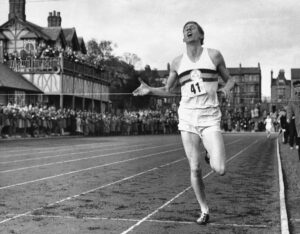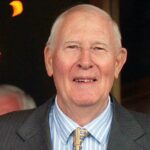
 World records come and world records go. Some take longer to beat than others. One record had stood for nine years. It was a record involving human endurance, and after a while, many believed that the recorded for the four-minute mile seemed like it just couldn’t be broken. so many athletes had tried and failed to break the record of 4 minutes 1.3 seconds set by Gunder Hagg of Sweden in 1945. Nevertheless, a hard to break record is a great motivator, and this one drew lots of athletes who were determined to break that record.
World records come and world records go. Some take longer to beat than others. One record had stood for nine years. It was a record involving human endurance, and after a while, many believed that the recorded for the four-minute mile seemed like it just couldn’t be broken. so many athletes had tried and failed to break the record of 4 minutes 1.3 seconds set by Gunder Hagg of Sweden in 1945. Nevertheless, a hard to break record is a great motivator, and this one drew lots of athletes who were determined to break that record.
By the early 1950s, and because so many athletes had tried and failed to run a mile in less than four minutes, people began to believe that it was a physical, and maybe even a phycological impossibility. Still, that seldom stops people from trying. In fact, in the early 1950s, several runners had dedicated themselves to being the first to cross into the three-minute zone. The goal became such a big deal that the crowds actually held their breath waiting for the time on a run to be announced. I’m sure that each failure was a colossal disappointment.
On May 6, 1954, in Oxford, England, 25-year-old medical student Roger Bannister finally succeeded in breaking track and field’s most notorious barrier…the four-minute mile. Bannister, who was born in Harrow, England, in 1929, was a top mile-runner while a student at the University of Oxford and at Saint Mary’s Hospital Medical School in London. He won British championships in the mile run, in 1951 and 1953. As he prepared himself for his first competitive race of the 1954 season, Bannister researched the mechanics of running and trained using new scientific methods he developed through his research.
Bannister came to the Iffley Road track in Oxford on May 6, 1954, for the annual match between the Amateur Athletic Association and Oxford University. Bannister was running for the Amateur Athletic Association and against his alma mater, Oxford University. The conditions that day were far from ideal. It had been windy and raining, and a considerable crosswind was still blowing across the track as the mile race was set to begin. At precisely 6pm, the starting gun was fired. Bannister had planned the race very carefully. He was aided by Chris Brasher, a former Cambridge runner who acted as a pacemaker. For the first half-mile, Brasher led the field, with Bannister a close second. Then, another runner took up the lead and reached the three-quarter-mile mark in 3 minutes .4 seconds. Bannister passed the mark at 3 minutes .7 seconds. Then, as he had planned, Bannister took the lead with about 350 yards to go and sprinted past an unofficial timekeeper at the 1,500-meter mark in 3 minutes 43 seconds, thus equaling the world’s record for that distance. Then, Bannister poured it on, throwing in all his reserves. When he broke the tape the time was 3 minutes 59.4 seconds. The announcer didn’t even get the whole time out before the crown erupted. All they needed to hear was “three minutes.” The rest didn’t matter, because the record had been broken!! Bannister’s official time was 3 minutes 59.4 seconds. It was very close to the 4-minute mark, but that didn’t matter, because .6 seconds still made it under four minutes. As soon as the first part of his score was the crown went wild!!
Bannister went on to win British and Empire championships in the mile run, and the European title in the 1,500-meter event in 1954. That was all it took for him. Going out on top, Bannister retired from athletic competition at the end of 1954, to pursue his medical career full time. He wrote a book about his experience in 1955, called The Four Minute Mile. Bannister went on to earn a medical degree from Oxford and became a neurologist. In 1955, Bannister married the Swedish artist Moyra Elver Jacobsson in Basel, Switzerland. Together they had four children…Carol Bannister (born 1957), Clive Bannister (born 1959), Thurstan Bannister (born 1960), and Charlotte Bannister (born 1963). In 1975, he was knighted by Queen Elizabeth II. He died of pneumonia at the John Radcliffe Hospital in Oxford on March 3, 2018.
As for his world record in the mile, well it did not stand long. The record continued to be lowered with 
 increasingly controlled climatic and surface conditions, more accurate timing devices, and improvements in training and running techniques. A “sub-four” mile run is still a notable time, but top international runners now routinely accomplish the feat. These days, the “mile race” has been replaced in the Olympics, because the mile is not a metric measurement. Nevertheless, it continues to be run by many top runners as a glamour event. While the sub-four race time is now a rather common time for the mile, no one else can claim the first-time record, because that belongs exclusively to Roger Bannister.
increasingly controlled climatic and surface conditions, more accurate timing devices, and improvements in training and running techniques. A “sub-four” mile run is still a notable time, but top international runners now routinely accomplish the feat. These days, the “mile race” has been replaced in the Olympics, because the mile is not a metric measurement. Nevertheless, it continues to be run by many top runners as a glamour event. While the sub-four race time is now a rather common time for the mile, no one else can claim the first-time record, because that belongs exclusively to Roger Bannister.


One Response to Sub-Four